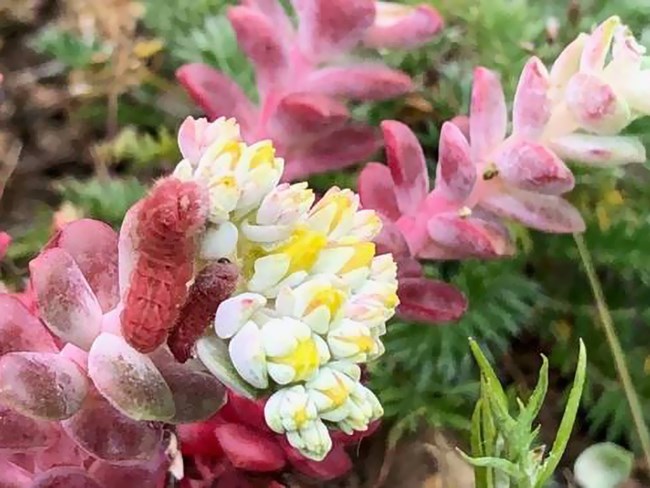Last updated: April 7, 2021
Article
San Bruno Elfin Monitoring Leads to New Clues and Questions at Milagra Ridge

Ariana Lease / GGNPC
March 2021 - Endangered San Bruno elfin butterflies are only found on the San Francisco Peninsula, on a handful of undeveloped steep, rocky hillsides where their caterpillars’ host plant, broadleaf stonecrop, still thrives. Milagra Ridge in Golden Gate National Recreation Area is one such spot. The Golden Gate National Parks Conservancy’s Park Stewardship Program has been keeping tabs on San Bruno elfins at Milagra Ridge since 1999. They’ve also been tracking open stonecrop flower clusters, also called inflorescences, since 2009. Just recently, they finished analyzing the results from their 2020 monitoring season, and the news is good. Program staff found an increase in caterpillars on inflorescences compared to 2019, and a record number of inflorescences. At the same time, some of their findings have left them with new questions.
Early on, San Bruno elfin monitoring involved biologists counting both adult butterflies and their caterpillars, or larvae. However, the small, brown, mostly sedentary butterflies proved too hard to find. Now, biologists focus on their easier-to-spot, yellow and red larvae. More specifically, their monitoring protocol focuses on third instar larvae, or larvae at their third developmental stage. That’s because, in theory, third instar larvae need to feed on open stonecrop inflorescences, making them even easier to find. But it’s turning out that inflorescences may not be the best place to look for third instar larvae.
When biologists would check inflorescences for larvae, they’d notice larvae on other parts of the stonecrop plants instead, especially on stonecrop rosettes. To quantify what they were seeing, they started recording larvae both on and off inflorescences in 2017. Thus far, counts of larvae on closed inflorescences and rosettes have far exceeded those found on open inflorescences. 2020 was typical in this respect, with 13 larvae found on inflorescences, and 70 elsewhere. These and other findings related to the early timing of peak larvae counts have led biologists to wonder about more than just whether third instar larvae really need to feed on flowers. For example, elfins vanished many years ago from a couple of stonecrop patches. Or could it be that biologists just weren’t detecting them because they were only checking inflorescences for larvae? So this year, biologists hope to:
- Search un-monitored stonecrop patches again for larvae, but not just on inflorescences;
- Test out an earlier start to the monitoring season, instead of waiting for the first stonecrop flowers to open;
- Figure out a better way of distinguishing between larval instars, or whether it’s important to distinguish at all;
- Establish photomonitoring to detect changes in elfin habitat over time; and more.
They may not get to everything, but whatever they can learn will undoubtedly yield new insights for better San Bruno elfin monitoring and conservation going forward!
For more information
- Golden Gate National Parks Conservancy: San Bruno Elfin Butterfly
- Contact Park Stewardship Program Senior Restoration Manager Christina Crooker or Golden Gate Wildlife Ecologist Bill Merkle
